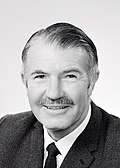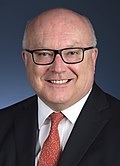Posting history
From Federation in 1901, the new Commonwealth government arranged to have all federal matters and communications handled by the various Agents-General of the states in London (acting with shared responsibility). Prior to federation, each of the Australian colonies were represented through the Agents-General, the oldest being South Australia from 1856. From 1905 the Agents-General formed a committee to jointly deal with Australian matters but on 20 February 1906, the Prime Minister, Alfred Deakin, announced the establishment of a dedicated Australian office in London, with the Secretary of the Department of Defence, Muirhead Collins, as the new office head. [5] The States of New South Wales, Queensland, South Australia, Victoria and Western Australia continue to be represented by agents-general. Since the revival of the NSW agent-general in 2021, Tasmania is the only state that does not have an agent-general in London, having abolished its post in 1981 as a cost-saving measure. [6] [7]
The High Commission of Australia in London is Australia's oldest diplomatic posting, and was created through the passage of the High Commissioner Act 1909 on 13 December 1909, which established the role as appointed by the Governor-General and defined that they would "act as representative and resident agent of the Commonwealth in the United Kingdom, and in that capacity exercise such powers and perform such duties as are conferred upon and assigned to him by the Governor-General [and] carry out such instructions as he receives from the Minister respecting the commercial, financial, and general interests of the Commonwealth and the States in the United Kingdom and elsewhere." [8] After the appointment of Reid as High Commissioner, Collins continued to serve as Official Secretary to the High Commissioner until his retirement in 1917. On 24 July 1913, King George V laid the foundation stone of Australia House, the future site of the Australia mission, which he also officially opened five years later on 3 August 1918. [5]
The High Commissioner Act was amended several times (1937, 1940, 1945, 1952, 1957, 1966) and was repealed by the High Commission (United Kingdom) Act Repeal Act 1973, when Foreign Minister Don Willesee placed the High Commission under the terms of the Public Service Act like all other diplomatic posts. [9] The new act altered the status of the High Commission to one of equality with all other bilateral posts, in recognition of the fact that Australia's relationship with the United Kingdom had changed. [5] Four of Australia's early prime ministers served terms as High Commissioner after leaving office: Reid, Fisher, Cook and Bruce. The position has also been filled by five people who have served as the leader of the opposition in the Australian parliament: Reid, Fisher, Cook, H.V. Evatt and Alexander Downer. Until 1973, every high commissioner was a former government minister. Since then, a number of senior career diplomats have held the post, although former politicians are still regularly appointed.
From 1975 to 2001, the work of the High Commission was assisted by the Australian Consulate in Manchester. Established on 1 August 1975, the consulate largely dealt with trade and migration matters. [10] [11]
Residence
Prior to 1950, the high commissioner lived in various rented premises. From 1910, the first high commissioner, Sir George Reid, rented the residence of John Henniker Heaton at 33 Eaton Square, Belgravia. [12] [13] In 1927, the government of Prime Minister Stanley Bruce acquired the lease of 18 Ennismore Gardens in Knightsbridge, from the Earl of Listowel (and succeeding Lord Castlemaine as lessee), a four-storey 1858 terrace house, as the residence for high commissioner Sir Granville Ryrie. [14] [15] [16] This remained the official residence until 1940, when high commissioner Stanley Bruce downsized to a smaller flat during the war years, and it remained empty until 1946, when high commissioner Jack Beasley took up residence. [17] [18] However, the Beasleys did not favour the size, style, and expense of this residence, and in late 1946 they moved to a smaller terraced house in Ilchester Place, Holland Park, which remained the official residence until 1950. [19] [20] [21] [22]
However, a need for a standalone official residence was identified by the Department of External Affairs, and a two-storey, 20-room, circa 1838 Georgian style residence known as "Stoke Lodge" at 45 Hyde Park Gate in Kensington was acquired in December 1950, with Resident Minister Eric Harrison, and his wife, being the first occupants. [23] [24] [25] [26] Since 1950, Stoke Lodge has been the official residence of all subsequent high commissioners, and often serves as an official reception venue. On 29 January 1952, high commissioner Sir Thomas White hosted Princess Elizabeth and the Duke of Edinburgh prior to their departure on a tour of Kenya, where Elizabeth would become Queen on 6 February. [27] [28] Stoke Lodge was originally built in 1838 by Robert Thew, a major of artillery in the East India Company, and in 1851 was the residence of Italian opera singer, Giulia Grisi. [29] Caroline Ashurst Stansfeld was also resident when she died in 1885. [30]
































